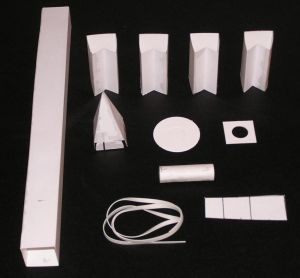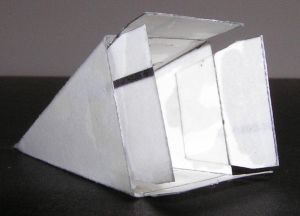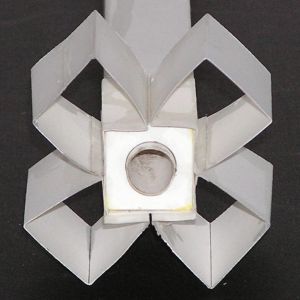Scratch Monolith Original Design / Scratch Built
Scratch - Monolith {Scratch}
Contributed by Geoffrey Kerbel
| Manufacturer: | Scratch |

Brief:
The Monolith is a single stage, mini motor all paper rocket.The Monolith
started out as one of those "lets see if this works" projects. After
many starts and stops, I was about to give up on the project when I found out
about the EMRR Challenge and saw some of the paper rockets that had been built
already. After seeing what really could be done with paper, I decided to put
the Monolith together. During the build process I actually changed the design
about three times until I had what you see now. I wanted to keep it simple but
not something commonly done and I definitely did not want to try to roll any
tubes! Triangle rockets are already out there so the square was the next
choice. I had a feeling it was going to look like the Washington monument but
figured I could do something fancy with the fins to offset that look. The wife
actually wanted me to make a brick facade and call it that. I just wanted to
make it look like it was a very heavy but small rocket, hence the
"rock" look.
Construction:
The first thing to do is print the patterns (Main(BMP 1M) and
Second (BMP 121K) onto
some 110# paper as I did or on the back of some glossy photographic paper. The
photo paper is used if you have access to a picture of some granite or marble.
(Hint: You can find textures in Microsoft PowerPoint under background textures.
Just make sure your printer puts this pattern on the full, complete sheet.) The
rocket body tube is a full 11" long. The photo paper is used so you can
print the patterns on the backside of the photo paper and the picture of the
stone on the good side. My printer would not do this and after many frustrating
tries, I just covered mine with marble looking contact paper. If you use the
photo paper, there will be no finishing required! After everything is cut out
and assembled, the Monolith will be fully "painted" and ready to fly.
The nose cone tabs and engine tube patterns are on the heavy paper only. The
engine mounting squares are from some standard Estes round CR-520 rings that
were cut down to size and squared up to fit the finished body tube. 1/8"
foam board or standard matte board would work great as well for the engine
mounting squares. Just make sure the center holes are aligned with each other
and wind up dead center in the body tube. Any offset thrust on this small of a
rocket will make for a very short flight!

Starting with the sub assemblies first, take an old 13mm engine and start the motor tube wrap around it. As you get to the paper again, add some white or yellow glue to the paper and continue to wrap. Be very stingy with the glue as you don't want to have the tube glued to the engine. Make it as tight as you can and as the glue starts to set up, remove the engine and set the tube aside.
Next up is the main body. Use thin CA here as it sets up faster and the parts will hold their shape better than waiting for the white or yellow glue to set up. If you are using plain paper, cut out the body pattern along the outside edge and lightly score the inside lines from the bottom to the top. Start folding at one side, crease and fold each section till the tube forms a square. Fold the tab in so that the tube side rests on the full length of the tab. If you are using the photo paper, cut along the outside lines and score the inside lines on the plain paper side. Follow this arrangement for all the other pieces as well.
The tricky part of this build was getting the main body tube glued together and forming a straight square tube at the same time. The paper seems to have a mind of its own. Mine did not want to stay in place or straight without having four or more hands. I finally came up with a solution: form the main body tube and use two clothespins to hold the top and bottom ends together along the seam line. The tab for all the parts always goes on the inside. I used thin CA on the joint starting at the middle and worked towards the top and then bottom using a drop or two to hold it together. Make very sure the tube is staying square as you do this! It sets up in about 15 seconds and then you can secure any loose sections with another drop or two of CA.
 The nose cone
is next and follows the same basic process. You can use one clothespin to hold
it together on the bottom and your fingers at the top. Glue the tab on the
inside again and set this aside.
The nose cone
is next and follows the same basic process. You can use one clothespin to hold
it together on the bottom and your fingers at the top. Glue the tab on the
inside again and set this aside.
The fins are just as easy to do, again using the clothespins at the top and bottom and gluing from the middle out to the ends. Make the fin sections all square at this time without the V fold on one side.
You can now go back to the motor tube and add an engine block to one end. You can roll some paper about 1/4" wide or use a 1/4" piece of an old 13mm case. Glue the motor block into the motor tube so that 1/4" of the engine is outside the tube. If you have had trouble grabbing this small of a motor, glue the block in only far enough so that you can get a good grip on the motor to remove it later. The motor assembly will be slightly recessed into the main body tube when finished so you need to plan for this now.
The nose cone tabs are next. The only reason I used this method was because my math is terrible and I could not calculate the proper sizing for an inside square ring to act as the nose cone shoulder. The four tabs work just as well, just not quite as tight as a full shoulder would be. If you can figure the math or the layout, make the shoulder however you want. Glue one tab to each side of the bottom of the nose cone. Use the half of the tab with the bevels to glue to the cone and the other half will be to hold the cone onto the rocket.
 The fins need
one side creased inwards to fit them onto the corners of the main body tube. I
used one side with the glue tab for this and took the two ends of that side and
gently folded them together so the side folded in right in the middle. This
gives you a matching V to fit the body tube. You can also glue the fins
directly onto the flats on the body tube for another type of arrangement
without the V. This would be a standard sort of tube fin arrangement. Mine had
to be different!
The fins need
one side creased inwards to fit them onto the corners of the main body tube. I
used one side with the glue tab for this and took the two ends of that side and
gently folded them together so the side folded in right in the middle. This
gives you a matching V to fit the body tube. You can also glue the fins
directly onto the flats on the body tube for another type of arrangement
without the V. This would be a standard sort of tube fin arrangement. Mine had
to be different!
Let's start with putting the motor mount in. If you are going to use a Kevlar® type mount, add it to the motor mount while you are adding the centering rings. Take the centering rings and carefully square them up to fit into the body tube. Make very sure the motor tube is centered and straight in the main body when added to the rings. I glued the rings to the motor tube first about 1/4" from both ends and then measured from the outside of the motor tube to each side to make sure it was centered as I fit the mount into the body tube. When you are sure you have the mount sized and centered properly, glue it into the body tube so the motor tube is flush with the bottom of the rocket.
Once that is set up you can add the fins. They too will be flush with the bottom of the rocket. Once dry, they tend to wobble a bit but this has not created a flight problem.
Take the launch lug and glue it centered into one fin inside edge by the body tube.
The shock cord is then glued to a tri-fold (Estes style) mount and glued into the top of the body tube on any one of the inside sides leaving enough room for the nose cone to fit into the top. Just tie it to the Kevlar® cord if you using that system. The other end is glued straight to the inside of the nose cone.
You can add some strength to the whole thing with some carefully applied CA to all edges of the fins, main body tube and nose cone tabs.
Finishing:
The rocket was too difficult to simulate so the string balance test was done.
As is, the rocket flew backward, which I expected and the addition of about
.5oz of clay to the tip of the nose cone balanced it out to fly forward. Swing
it around on the string and add only enough weight that is needed on your
rocket to have it fly correctly! Too much on this one really hurts the
performance.
On mine, putting on all that contact paper was a pain and to cover the white inside the fins, I used a Sharpie pen to black the whole thing out. I also like to do this on the lower motor mount ring and the inside of the lower body tube. It just looked better to me.
Flight:
The first flight was on a 1/4A3-2T and it was as comical as it could be. The
motor finished its burn just after the rocket left the 36" launch rod, got
up about 12' and flopped back down 6" from the launch pad. The ejection
charge went off with the nose cone whiffing out about 2". I got that one
on video with the sound of everyone laughing in the background! To say it was
underpowered was an understatement! Hey! If you can't have spectacular flights,
at least have spectacular failures! However I may use that combination on the
next spot-landing contest!
The next flight was on a 1/2A3-2T and was a repeat of the first with just a little more height.
Well, that was not good enough and I was going to use an A3-4T next but realized I had not brought them with me so I went for broke and friction fitted in an A10-3T and let it rip. Rip it did, really showing that this bird could fly with the best of them! Nice straight boost to about 300' with the nose cone coming out just past apogee. That is when I realized it needed to be slowed down on its descent with something as it came in way too fast. The nose blow was not enough drag. Luckily, it tended to go horizontal a bit and it landed hard but flat on its side. Amazingly still no damage after all this abuse!
For the last flight with this rocket for the day, I added a 1" x 12" crepe paper streamer about 2" down from the nose cone and had a beautiful boost and a really beautiful full streamer float down to a finally soft landing. This was going to be the engine from now on and the streamer as well.
Recovery:
If you can get this one to fly without any nose weight, the nose blow recovery
may be enough. The streamer works almost too well, the rocket streamer and nose
cone come down first with the rocket body landing horizontal next. The only con
is I have found some scorching of the inside of the body tube after four
flights. I would recommend a paper liner be added before each flight or fit a
short length of 1" regular body tube (BT-20) inside as I did to correct
the problem.
Summary:
All and all it was a fun project with a surprisingly great flying bird! I just
may make some more of them with some wild paint jobs added on. The only CON is
I still have a bunch of really small motors and no bird to use them on!
Sponsored Ads
 |
 |











